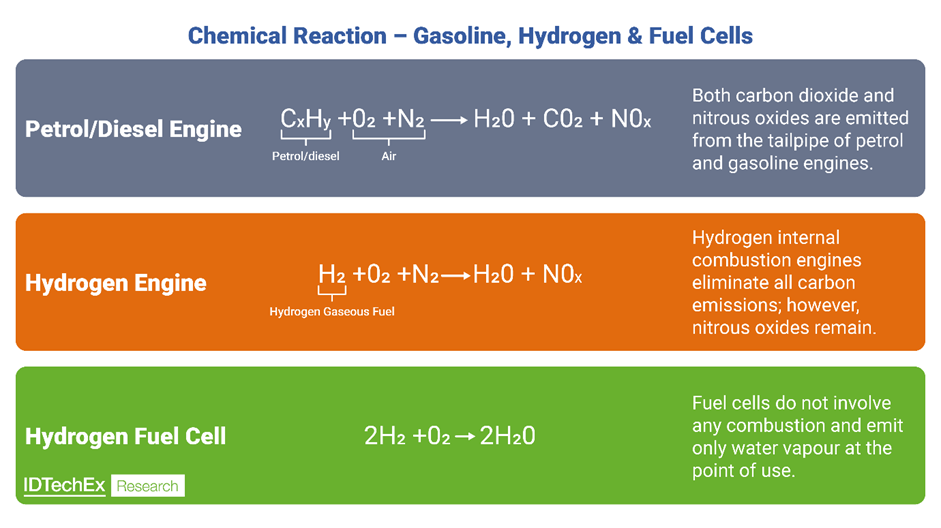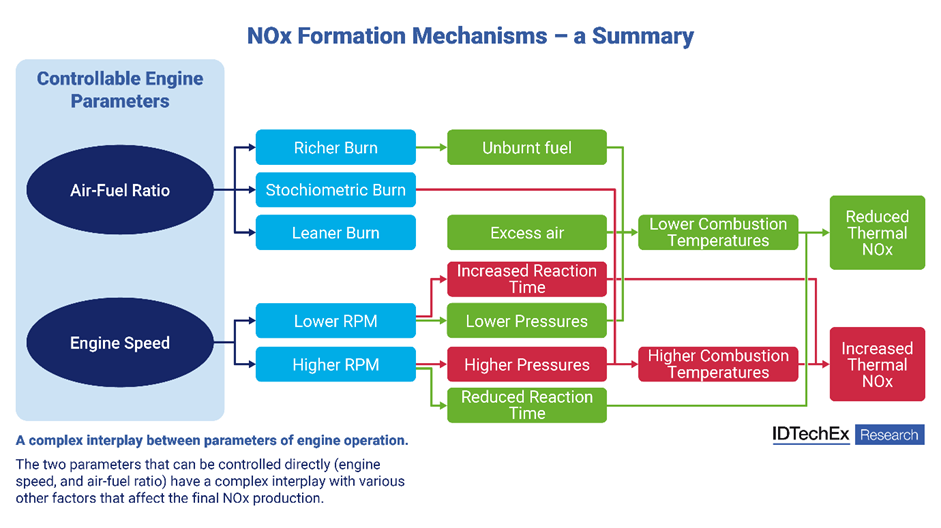
Author: Mika Takahashi, Technology Analyst at IDTechEx
Internal combustion engines (ICE) but without the emissions. The idea is certainly appealing. Keeping the same internal combustion engines (ICE) that have powered cars, buses, and trucks for well over a century, but eliminating the damaging and climate-affecting emissions that escape from the tailpipe. Currently, electrification is the primary route to decarbonizing transportation, but battery electric solutions bring many challenges, meaning adoption is likely to be a slow process – IDTechEx estimates that 11% of all car sales in 2023 were fully electric.
Could engines running on hydrogen keep the best of both worlds, familiar and mature ICE technology with zero emissions? IDTechEx’s report, “Hydrogen Internal Combustion Engines 2025-2045: Applications, Technologies, Market Status and Forecasts”, explores the emissions credentials of this potentially disruptive technology.

An overview of the chemical reactions involved in a petrol/diesel engine, hydrogen engine, and hydrogen fuel cell. The lack of carbon in combustion within hydrogen engines eliminates CO2 emissions (apart from trace amounts from motor oil). Source: IDTechEx
A carbon-free fuel, so no carbon in the exhaust?
Combustion is a high-temperature chemical reaction between a fuel and an oxidant (in the case of engines, this is atmospheric oxygen). In a conventional ICE fuelled by petrol or diesel, the hydrocarbon reacts with oxygen and nitrogen in the air at high temperatures to produce heat, water vapor, carbon dioxide, and nitrous oxides. No carbon is present in the chemical reaction when switching to a pure hydrogen fuel; therefore, no CO2 is formed and emitted into the atmosphere. There is a slight caveat to this zero CO2 however. IDTechEx research indicates that a small amount of motor oil will be burned in an ICE. Motor oil is essential to lubricate the intricate moving parts and prevent damage from metal-metal contact. Most engines will burn a small amount of oil due to leakages or blowback in the system, and as all motor oils currently in use are hydrocarbon-based, this does lead to a small amount of CO2 being produced. However, when compared to the amount of CO2 emitted by a conventional ICE, the amount is negligible. IDTechEx estimates that less than 1kg of CO2 would be produced per 1,000 miles from burning motor oil in an H2ICE vehicle, compared with 272kg in a conventional ICE. Thus, an H2ICE would have around 99.7% less CO2 emissions than a conventional ICE.

IDTechEx research outlines the key engine parameters and the impacts these have downstream on thermal NOx formation. NOx is a key pollutant of concern regarding H2ICE, and tailpipe emissions must be kept as low as possible for H2ICE to offer credible emissions reductions. Source: IDTechEx
Nitrous oxides pose the greatest challenge
While there is no carbon in the fuel, the combustion of hydrogen causes very high temperatures in the combustion chamber, and this does lead to nitrous oxide formation. Nitrous oxides (NOx) have been recognized as greenhouse gases (GHGs) and harmful to air quality for decades. Increasingly strict regulations on the permissible tailpipe emissions of NOx have been implemented globally as the harms of NOx have become more apparent. For H2ICE to have credible emissions reductions, it must also show that it can reduce NOx emissions substantially. The formation of thermal NOx (NOx formed in high-temperature combustions) is a highly complex interplay of factors and engine parameters.
IDTechEx breaks down each of these factors in turn within the report, examining the latest academic research and industry trends such as:
- Influence of air-fuel ratio on NOx formation and why the industry is tending towards lean burn spark ignition (SI) designs.
- Impact on engine speed on NOx formation due to pressure and reaction time.
- Applicability of existing compression ignition (CI) and SI exhaust gas after treatment to hydrogen engines.
- Performance and operational principles of 2 and 3-way catalytic converters, selective catalytic reduction, lean NOx traps, and exhaust gas recirculation (EGR).
- Real-world performance data for existing H2ICE vehicles.
- Contextualisation of H2ICE NOx emissions with historic and current tailpipe limits (g/km and g/kWh) in key regions.
- Discussion of emissions for sectors beyond road transportation, including aviation.

An overview of the colors of hydrogen. Hydrogen is not readily found in nature, so it must be produced, and the production method is key to determining the life-cycle emissions of a hydrogen internal combustion engine. Only green or yellow hydrogen offers near zero CO2 emissions throughout their production. Source: IDTechEx
When it comes to hydrogen, color is key
Although the hydrogen fed into the engine may be carbon-free, its overall life-cycle emissions depend greatly on its origin. In the hydrogen industry, the ‘color’ of hydrogen is used to denote the production method. Of the rainbow of colors available, green and yellow hydrogen are the only truly renewable sources. However, these are currently both hard to acquire and prohibitively expensive, in part due to the low energy efficiency conversions. 3kWh of renewable electricity makes roughly 1kWh in usable hydrogen. To be fed into an engine, it must then be compressed, transported, stored, dispensed, and finally burned in a heat engine with limited thermal efficiency. The result is a lot of energetic inefficiencies, which amplify any emissions involved in production. While the emissions produced for green hydrogen are minimal, this becomes a major consideration for other colors of hydrogen.
In the report, “Hydrogen Internal Combustion Engines 2025-2045: Applications, Technologies, Market Status and Forecasts”, IDTechEx assesses the overall lifecycle emissions of a H2ICE vehicle, including:
- Green, blue, and grey hydrogen estimated CO2 emissions (in g/km).
- Comparison with a fuel cell electric vehicle (FCEV, a hydrogen-powered electric vehicle) across the same colors of hydrogen.
- Benchmark comparisons of diesel/petrol as well as a battery-electric vehicle charged under a range of grid scenarios.
To find out more about this IDTechEx report, including downloadable sample pages, please visit www.IDTechEx.com/H2ICE.
For the full portfolio of hydrogen market research available from IDTechEx, please see www.IDTechEx.com/Research/Hydrogen.
Upcoming free-to-attend webinar
Hydrogen and Fuel Cells: Progress in 2024 and the Road Ahead
IDTechEx will be hosting a free-to-attend webinar on the topic on Monday 2 December 2024 – Hydrogen and Fuel Cells: Progress in 2024 and the Road Ahead.
Webinar contents will include:
- Background on the hydrogen value chain, from production to end-use applications
- Significant developments in low-carbon hydrogen production, storage, distribution, and industrial applications in late 2023 and 2024
- Overview of various fuel cell technologies
- Major trends for fuel cells in automotive and stationary power markets
- Market outlook
We will be holding exactly the same webinar three times in one day. Please click here to register for the session most convenient for you.
If you are unable to make the date, please register anyway to receive the links to the on-demand recording (available for a limited time) and webinar slides as soon as they are available.
